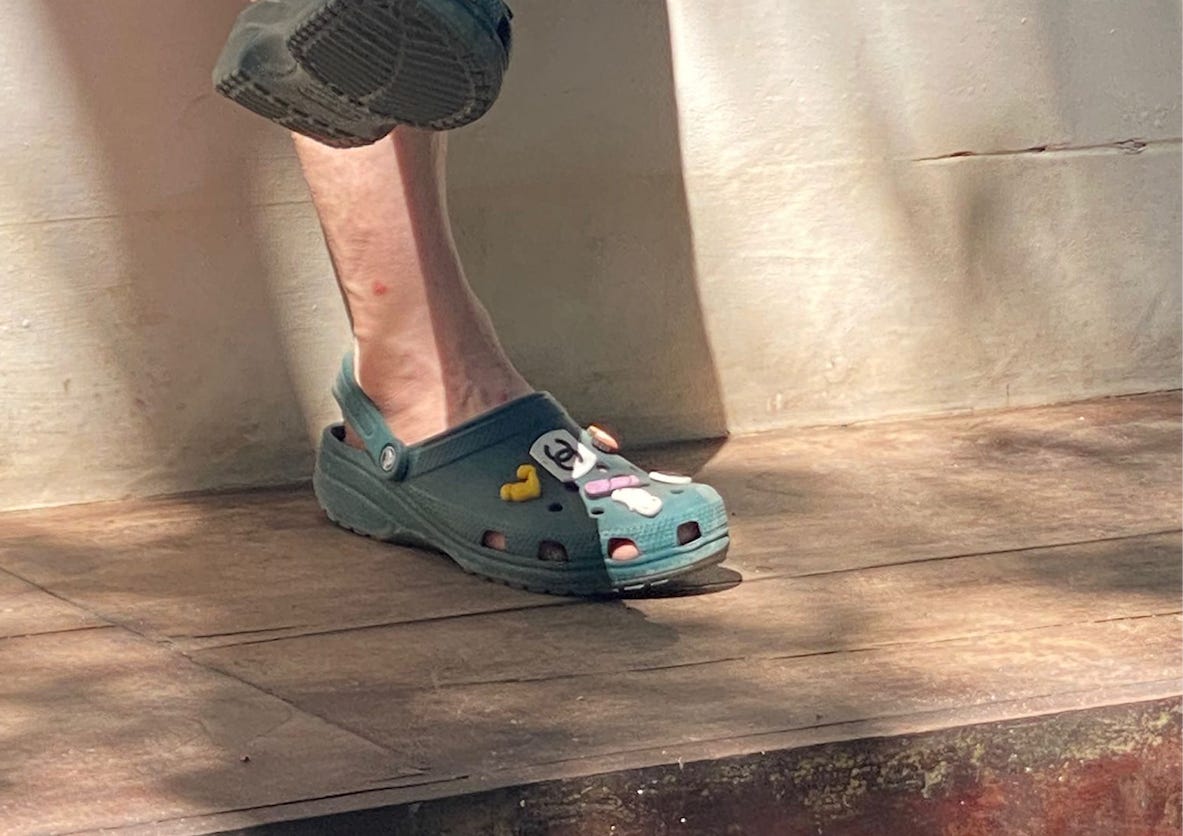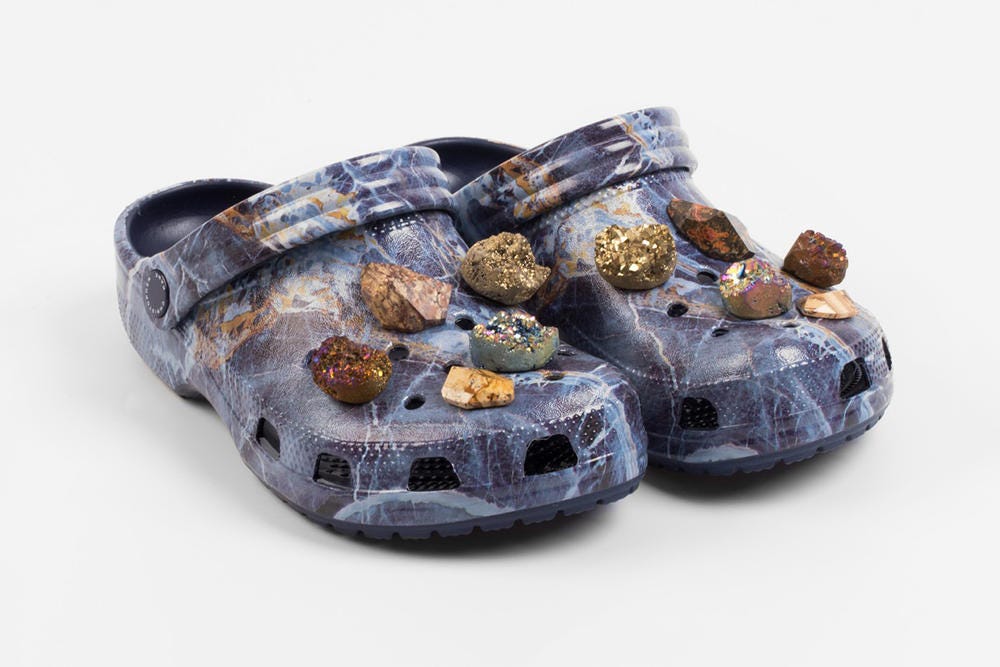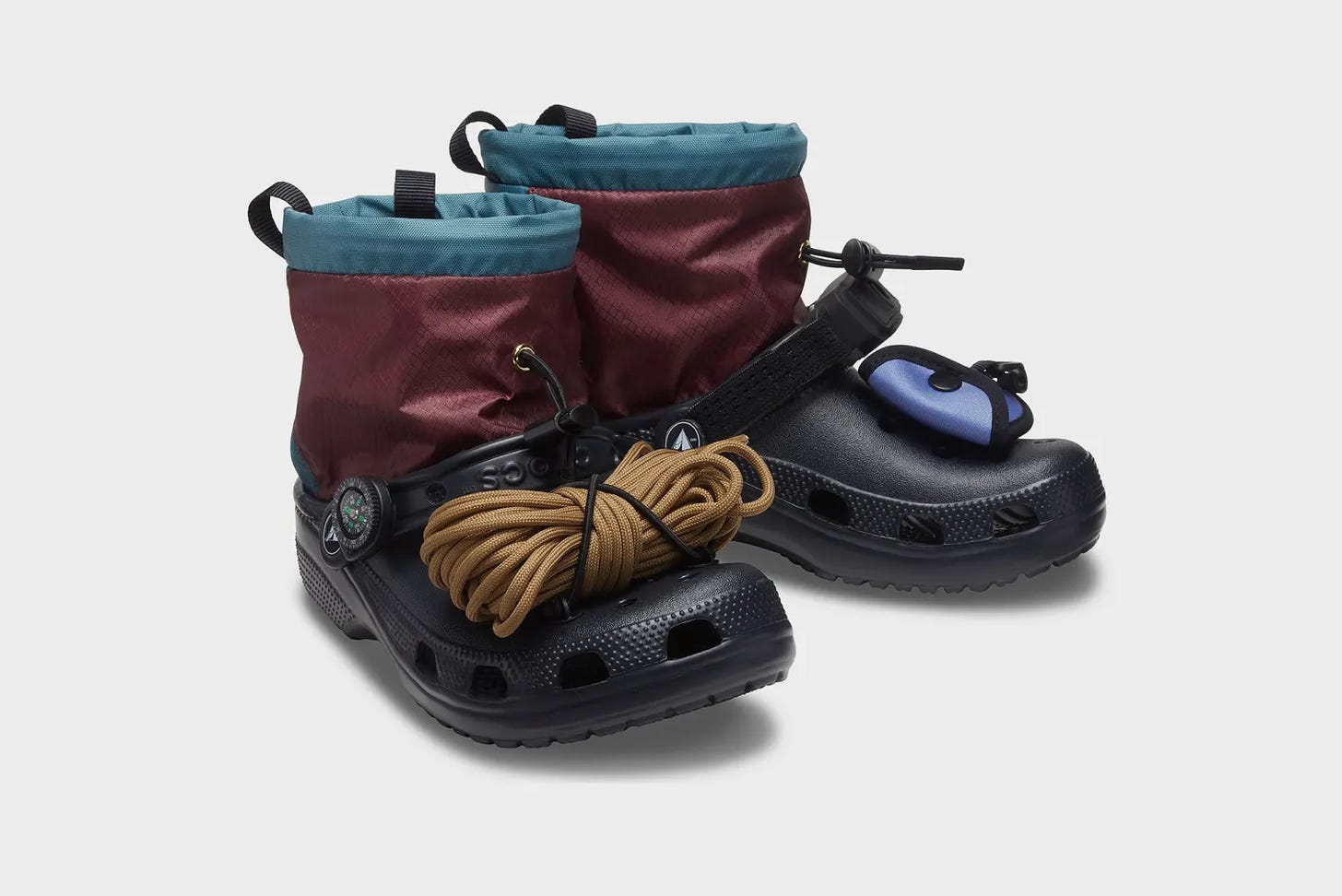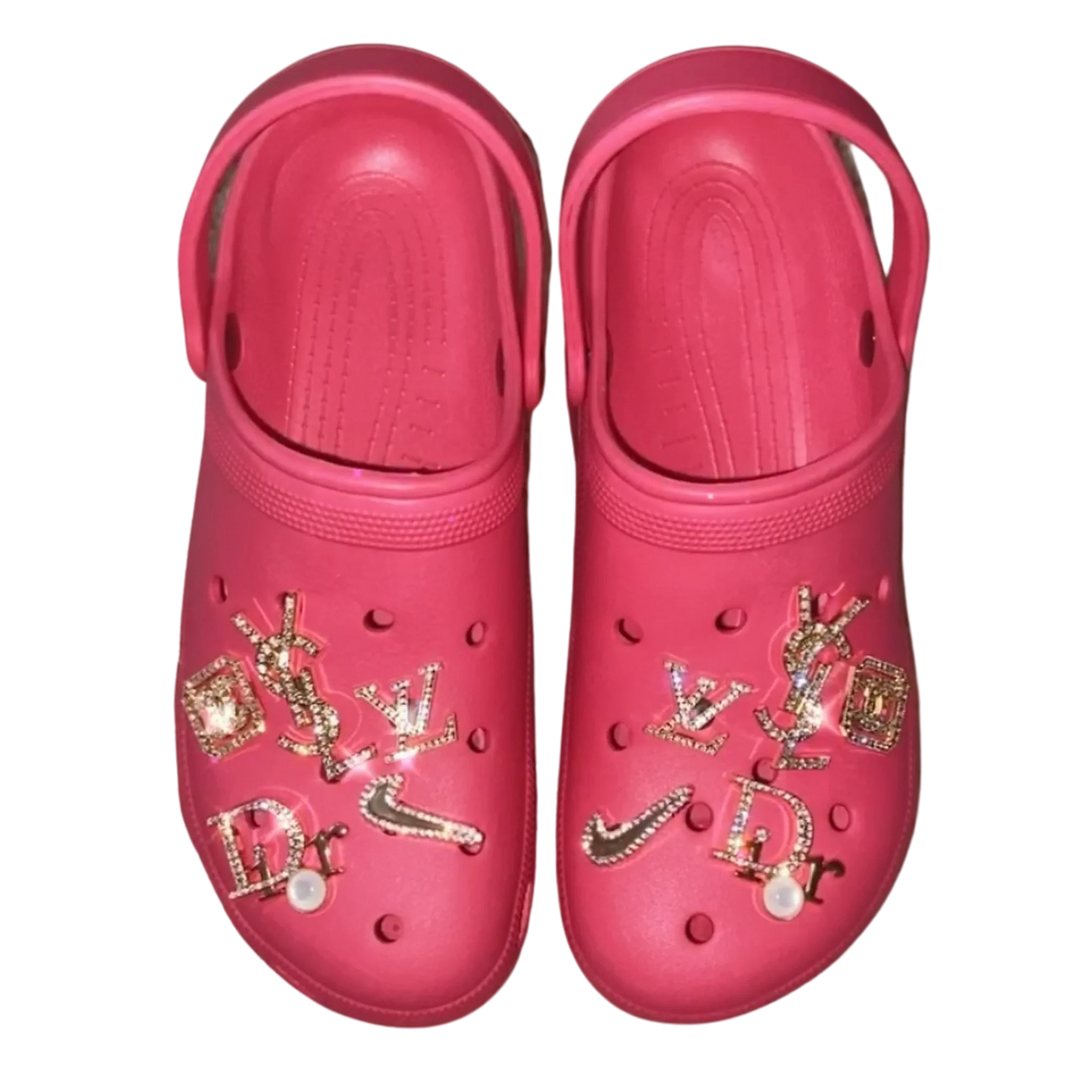JPEGs & Crocs 5 Things in Common
Aesthetic abominations or cultural commodities we hate to love, Crocs and JPEGs are more similar than you might think.
On a recent holiday, I had the good fortune of being sat across from this ↓ Croc-clad individual.
With EV foam footwear of rich aquamarine, embellished with Jibbitz Charms™ including Chanel's trademark double-C (placed just as Karl intended), this man and his medium for self-expression reminded me of the JPEGs I know and love.
But how does a breathable shoe, optimised for comfort, remind anyone of digital goods more uncomfortable to hold/ create/ acquire than striding down cobbles in a pair of Pigalles 3 sizes too small? You may ask. Well, for 5 reasons:
1) Ascetic re-definition
A wise man once observed: NFTs are ugly.*
This could be because they’re countercultural, self-referential, and deeply ironic. One could even go as far as to say that the voxelized aesthetic is a comment on the blockchain (instead of merely poor taste and sub-par computer graphics). Yet consciously or unconsciously, and whoever is to blame, the majority of blockchain-based digital art looks like something our child has drawn which we’re forced to congratulate them on before stuffing into the chasms of our deepest draw/garbage can/toilet bowl. The same is true of Crocs.
Integral to note here, is that much like the winner of an ugly dog contest, this absence of attractiveness is not these goods' biggest weakness, but rather their greatest strength.
The proliferation of articles strewn across the internet proclaiming “Crocs are Ugly!!!” can be directly linked to the company’s revenue of $1.4 billion (2020).
In fact, one Fast Company article states:
“From the start, the brand has been aware of how polarizing its shoes are, inspiring feelings of disgust from many consumers. But rather than defend itself against these antagonists, it has harnessed the hatred to create a narrative about how the shoe represents radical inclusivity and individuality–values that are increasingly important, particularly among young people”
So too with NFTs.
Valued at $11.16bn at their 2021 peak, JPEGs, aka. “crypto art”, represent a community of ‘degens’ — self-defined anarchists excluded from the traditional arts and culture space (and since his Bored Ape purchase also Justin Bieber).
Furthermore, just as Crocs have garnered global awareness through their undeniable fugliness, when you take out your phone to show your Bored Ape/Goblin/Punk at the dinner table, no matter if the viewer understands the nuances of the project, the undeniably janky aesthetic is likely to identify it as an NFT.
As Michelle Poole, Crocs President puts it,
“You can show our iconic silhouette throughout the world, and people everywhere can identify it as Crocs, which is unusual.”
2) Zeitgeist
This brings us on to Zeitgeist, defined in German philosophy as: the general intellectual, moral, and cultural climate of an era.
What Crocs were to the 2000’s, JPEGs are to this third iteration of the digital age.
Both reminiscent of questionable intellectual, moral and cultural choices, Crocs can be paired with pink-streaked GHD-ed hair, slashed bell bottoms & text tagged tops, while JPEGs mould memories of snaggletooth CryptoKitties, melancholic monkeys and endlessly iterated pixel-punks. Or, for those who prefer the real-world, endless troves of men in merch (telling anyone who’ll listen that their JPEG-jewelled smart watch is more valuable than any given Rolex). Yes, just as a true fashion lover shudders at the site of the foam-foot-frames in the hallowed halls of a luxury department store, so too a #tradart lover cringes at the apathetic apes adorning the walls of Sotheby's or Christie's.
3) Brand appropriation
How do you know you’re a true beacon of the zeitguist? When the gatekeepers of #tradculture come knocking at your door.
Crocs began their ascent into culture sometime between their conception in 2002 and their ubiquity with the horrors of heatwaves in 2006. But it wasn’t until 2014, when private equity firm Blackstone acquired the brand and set about the task of “making them cool” that cultural copulation began to take place.
In 2016 fashion designer Christopher Kane did his inaugural Crocs collection. Shortly after, Balenciaga’s creative director, Demna, designed bubble-gum-pink Crocs, with four-inch platforms and custom Jibbitz. And, as is common in the fashion-forward mentality, once the pen-gates were opened, the sheep flocked in.
With JPEGs we’ve witnessed this same transition. But rather than over a 14 year time horizon, NFTs have gone from persona non-grata to name-to-know in a period of just 14 months.
To reel off a few of these #tradculture synergies: we’ve seen dedicated JPEG sales at Phillips, Christie's, Sotheby's and Art Basel; (mostly miserable) luxury lines from Balmain, Burberry, D&G and Givenchy alongside a Gucci collection created exclusively for Bored Apes (#JPEGonJPEGonJPEG). Most recently, Tiffany accompanied its cousin TAG Heuer with products specifically targeting the JPEG buyer; the former creating a line of 250 custom necklaces for holders of CryptoPunks, and the latter a smart watch optimized for displaying NFTs.
4) Derivatives
NFTs are famous for allowing their holders to experiment with intellectual property to varying degrees.
If I own a Bored Ape for example, I can use my Ape to create a bar or spin out a new media venture (the project known as Jenkins the Valet recently raised $12 million from a16z for exactly this). The underlying theory being, as more people create their own Ape-centric experiences, the Bored Ape brand's value will go up; making Apes more desirable for purchase; and with the original curators, receiving 2.5% royalties on every resale, this licensing is lucrative to say the least.
Though Crocs do not give their owners the ability to legally create Croc-co’s (whatever Depop might lead you to believe…) they have leant into creator-consumer collaborations more than almost any other footwear brand.
The #personalizeyourcrocs competition of 2019 saw consumers compete for a chance to live paint their designs, with $1,500 in prizes. Additionality also came in the form of collabs with niche influencers such as Nicole McLaughlin's ‘Campsite Classic Clog’, Salehe Bembury’s cult coveted ‘Pollex Clog’, Mastermind Japan’s 'Cyberpunk Croc' and Byron Murphy’s 'Croc Cleats' (inspired by Nike Cleats).
By encouraging creators and consumers to co-create and collab both Crocs and JPEGs lean into the power of the remix (albeit to differing degrees and with differing incentive structures) to retain relevance and suck in new segments.
5) Composability
Finally, we come to composability.
To give the least technical definition, someone who owns a composable NFT has the ability to add further elements to their asset before they sell it on.
Jibbitz Charms™ (personalization pins boasting 1000’s of sellers on Etsy, Depop, Amazon as well as officially sanctioned Croc-Curators) are Crocs' coefficient for this very attribute.
Whilst faking foam-footwear can land you time in jail, the holes in Crocs create conduits for co-creation. Just as Demna’s Digits can be remixed with a snail your cousin bought on Etsy, you can wrap BTC or embed further collectibles into your composable NFT.
Compounding value, these plug and play pieces allow the holder to capitalize on customization serving as 1) markers of a holder's identity 2) a channel for their creativity 3) a source of additional value if they choose to resell.
Crocs and JPEGs never die...
Much like my Burning Man ticket, my mum unites both Crocs and JPEGs through their status as things that I should be paying NOT to own.
Yet all jokes aside, these items are united by uniqueness; with ardent superfans/ superhaters elevating them as irrevocable icons.
Historically immortalized and endlessly upgraded, Crocs and JPEGs stand as pinnacles of consumer culture, going down in human history as things we shouldn’t have (but nonetheless emphatically) bought.
WRITTEN BY DANI LOFTUS
*Artblocks items excluded








